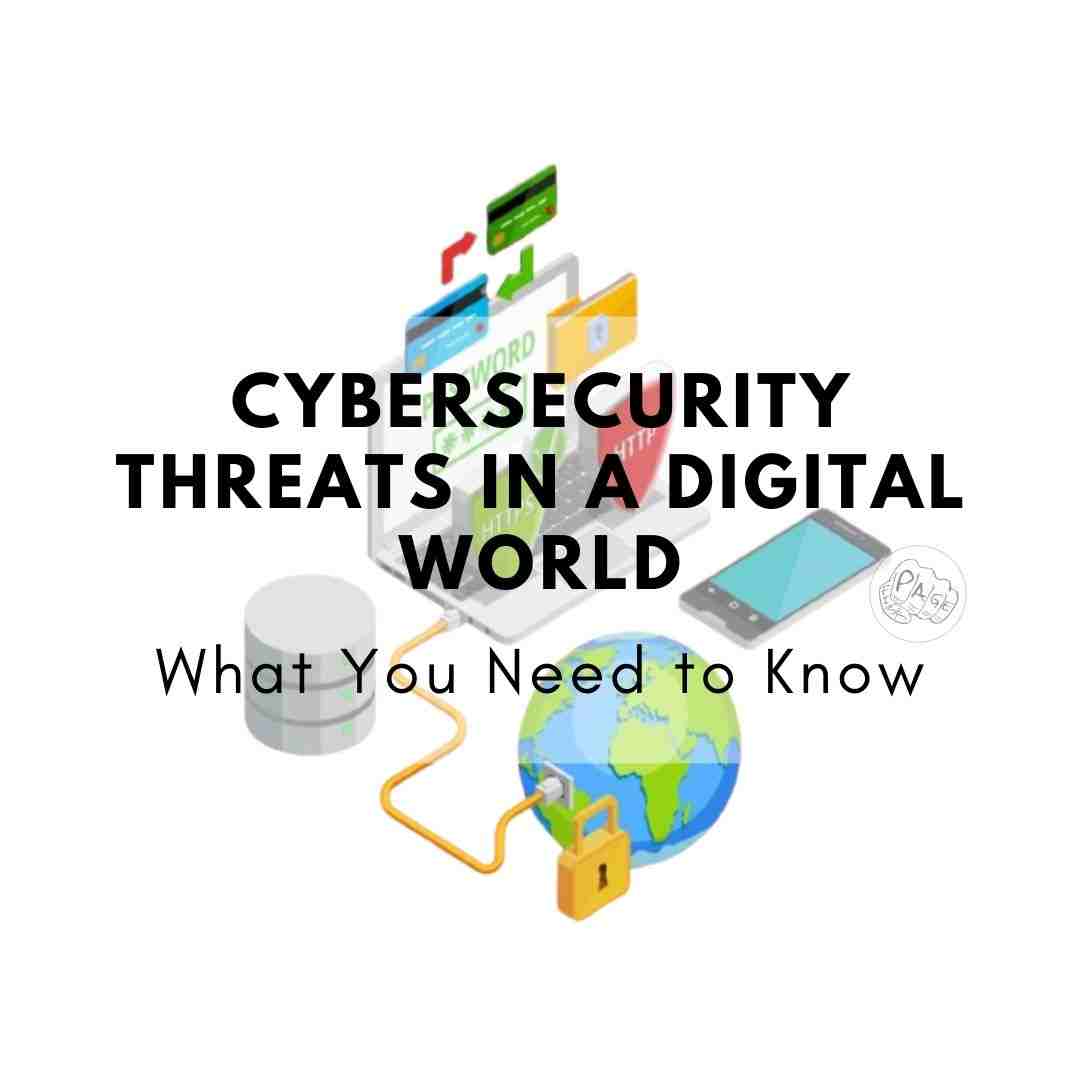Cybersecurity Threats in a Digital World: What You Need to Know
Discover the top cybersecurity threats in today's digital landscape and learn how to protect yourself and your data. Stay one step ahead of cybercriminals!
Introduction
In a world where technology reigns supreme, the digital realm is both a treasure trove of opportunities and a minefield of cybersecurity threats. From your personal data to your financial information, everything you hold dear can be at risk if you're not vigilant. But fear not! This article is your trusty guide to navigating the perilous waters of the digital world. We'll delve into the most cunning cybersecurity threats, equip you with the knowledge to defend yourself, and provide you with practical tips to stay one step ahead of the cybercriminals!
The Rise of Cybersecurity Threats: A Digital Nightmare!
The digital age has brought us unprecedented convenience and connectivity, but it has also opened Pandora's box of cybersecurity threats. As we plunge deeper into this cyber frontier, the threats evolve and multiply like digital rabbits on steroids. Let's dive into the most menacing ones you need to be aware of!
1. Phishing Attacks: Hook, Line, and Cybercriminal!
Phishing 101: Reeling You In
Phishing attacks are like the chameleons of cyber threats. They disguise themselves as trustworthy entities—banks, government agencies, even your beloved email provider—only to lure you into their devious webs. Cybercriminals use cunningly crafted emails or messages to trick you into revealing sensitive information like passwords or credit card details.
- How does it work?
- You receive an email that looks legit, but beware of those pesky typos!
- They urge you to click on a link that takes you to a fake website that mimics the real deal.
- You input your login info, and bam! Your secrets are out in the wild.
What You Need to Know:
Phishing attacks are more convincing than ever, and cybercriminals are getting better at imitating trusted sources. Always scrutinize emails for red flags, such as poor grammar, unexpected requests for personal info, or email addresses that seem slightly off.
2. Ransomware: Pay Up or Lose It All!
Ransomware Unleashed: Your Data's Hostage Drama
Imagine waking up one day to find your computer's files encrypted, and a menacing message demanding a hefty ransom in cryptocurrency to decrypt them. That's the chilling reality of a ransomware attack! Cybercriminals hold your data hostage until you cough up the cash.
- How do they strike?
- You unknowingly download malicious software, often through deceptive email attachments or sketchy websites.
- Once in, ransomware encrypts your files, rendering them inaccessible.
- You're left with a digital ransom note demanding payment for the decryption key.
What You Need to Know:
Ransomware attacks can cripple individuals and organizations alike. Regularly back up your data offline, and be cautious when opening email attachments or clicking on suspicious links. Prevention is your best defense against these digital extortionists!
Cybersecurity Threats: Not Just for Computers Anymore!
In the digital era, it's not just your computer that's vulnerable. Our interconnected world means cyber threats can come knocking on the doors of your smart fridge, thermostat, or even your baby monitor. Here's a quick rundown of the emerging threats targeting your everyday devices.
3. IoT Insecurity: Your Smart Devices, Their Playground
IoT: An Invitation for Cyber Intruders
The Internet of Things (IoT) is a technological marvel, connecting everything from your fridge to your fitness tracker. But the downside? These devices often have lax security, making them easy prey for cybercriminals.
- How do they exploit it?
- Weak passwords and outdated software on IoT devices are like open doors for hackers.
- Once inside, they can snoop on your home, steal personal data, or even turn your gadgets into part of a malicious botnet!
What You Need to Know:
Change default passwords on your IoT devices, keep their software updated, and segment your network to isolate smart devices from critical systems. Don't let your smart toaster become a gateway for cyber villains!
4. Social Engineering: Hacking Humans, Not Computers
Social Engineering: The Art of Psychological Hacks
Cybercriminals often target the weakest link in the cybersecurity chain: humans! Social engineering is all about manipulating people into revealing sensitive information or performing actions that compromise security.
- How do they pull it off?
- Pretending to be a coworker, they might ask for your login credentials.
- Through a fake charity, they could trick you into making a hefty donation.
- Over the phone, they might pose as tech support, urging you to install malware on your device.
What You Need to Know:
Stay vigilant and skeptical. Verify the identity of anyone asking for personal information or requesting actions that seem out of the ordinary. Trust, but always verify!
The Dark Web: Where Cybersecurity Threats Thrive
The digital world has a dark underbelly known as the Dark Web, where all sorts of nefarious activities take place. It's like the Wild West of the internet, where cyber outlaws roam free. Here's a glimpse into this cyber-wilderness.
5. Dark Web Marketplaces: A Black Market for Everything
Dark Web Markets: Cybercrime's Superstore
The Dark Web is the ultimate hideout for cybercriminals. It's a place where you can buy anything from stolen data to hacking tools, drugs, and even hitman services—all in virtual anonymity.
- What's the deal?
- Cryptocurrencies are the preferred payment method, ensuring transactions remain untraceable.
- Dark web marketplaces operate on the Tor network, hiding both buyers and sellers.
What You Need to Know:
Steer clear of the Dark Web at all costs. Visiting this digital underworld can land you in hot water with the authorities, not to mention the risk of falling victim to scams or cyberattacks.
How to Fortify Your Digital Fortress
Now that you're well-versed in the art of cybersecurity threats, it's time to armor up and protect yourself in this digital battlefield. Here are some practical steps to secure your digital life.
6. Password Hygiene: The First Line of Defense
Passwords: Your Digital Keys
Your passwords are the keys to your digital kingdom. Make them strong and change them regularly. Here's how:
- Use a mix of upper and lower case letters, numbers, and special characters.
- Avoid using easily guessable info like your birthday or "password123."
- Consider using a reputable password manager to generate and store complex passwords securely.
7. Two-Factor Authentication (2FA): Adding an Extra Layer
2FA: Don't Stop at the Front Door
Two-factor authentication is like adding a second lock to your digital door. Even if cybercriminals crack your password, they'll hit a roadblock without the second authentication factor.
- Popular 2FA methods include receiving a code via text message or using authentication apps like Google Authenticator or Authy.
- Enable 2FA wherever possible, especially for your email, social media, and banking accounts.
8. Regular Software Updates: Patching the Holes
Updates: An Ounce of Prevention
Software updates aren't just about adding new features; they often contain crucial security patches. Keep your operating system, browsers, and applications up to date.
- Enable automatic updates to ensure you're always protected.
- Don't ignore those pesky reminders; they're your digital guardian angels!
9. Educate Yourself and Your Family
Knowledge is Power: Share It
Cybersecurity threats affect everyone in your household. Educate your family, especially kids, about online safety.
- Teach them about the dangers of clicking on suspicious links or sharing personal information.
- Encourage open communication, so they know they can come to you if they encounter anything suspicious online.
Conclusion: Stay Cyber-Vigilant, Stay Safe!
In this digital age, cybersecurity threats are the shadowy foes lurking in the darkest corners of the internet. But armed with knowledge and the right tools, you can fend off these virtual villains and protect your digital kingdom. Remember, it's not a matter of if, but when, a cyber threat comes knocking. Be prepared, stay vigilant, and you'll emerge from the digital battleground unscathed. So, keep your passwords strong, activate 2FA, and never underestimate the power of cyber-awareness. Your digital future depends on it!
Cybersecurity Threats in a Digital World: What You Need to Know is your ultimate survival guide in this digital wilderness. Share it with your friends, family, and colleagues, and together, let's create a safer digital world for all!
Share This Post
Related Articles
Cybersecurity Essentials: What Every Business Leader Must Know
Protecting your business in the digital age is crucial! Discover the cybersecurity essentials every leader should know for a secure and thriving enterprise.
Cloud Security
Cloud security is the practice of protecting data, applications, and infrastructure from cyberattacks and unauthorized access in the cloud. Cloud security requires a shared responsibility model between the cloud service provider and the customer, as well as the implementation of security controls, policies, and best practices. Cloud security can help organizations achieve compliance, scalability, and cost-efficiency in their cloud operations.
The Dynamic Duo: AI and Humans in Cybersecurity
Explore the symbiotic relationship between artificial intelligence (AI) and human expertise in the ever-evolving landscape of cybersecurity. Learn how these digital defenders work together to fortify digital defenses and ensure comprehensive protection against digital threats.
Guide to Deal With Fake Social Media Profiles
Elevate your online safety with our comprehensive guide on dealing with fake social media profiles. Learn expert strategies to recognize and report deceptive accounts, ensuring a secure digital presence. Stay ahead in the digital realm with our essential insights.
Vulnerability assessment
A vulnerability assessment is a process of identifying, analyzing, and prioritizing the risks and weaknesses of a system or network. It helps to determine the level of exposure to potential threats and the impact of a breach or attack. A vulnerability assessment can also provide recommendations for mitigating or resolving the identified vulnerabilities.
Related FAQ
No related FAQ.
Say Hello
To Your Dream





